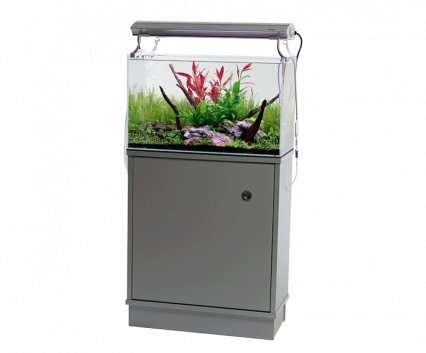Do you believe all that advice that everyone wants to throw at you regarding planted aquariums? Be baffled no more, as George Farmer happily separates the fact from the fiction.
1. Plants require soft water
Every plant I’ve owned I’ve successfully grown in hard water, including some of the hobby’s most demanding species.
Some, such as Vallisneria, thrive in hard water as they utilise the bi-carbonates. Those with very soft water may need to supplement magnesium, calcium and potassium levels in addition to their regular fertilisers. Some with extremely hard water have found it hard to grow certain species and require more CO2.
However, I have known aquascapers in London, having some of the UK’s hardest water, enjoy success with any plant they wish to grow.
Softer water is recommended for certain fish, especially for breeding, but if growing plants with bread and butter fish there should be no need to soften water.
2. Planted tanks will do best with heater cables
I have run more than 30 planted tanks without heater cables, many long term, and many aquascapers and planted aquarium hobbyists no longer consider them effective.
Heater cables can be relatively expensive and in some situations are not recommended. One manufacturer of a complete soil-based product now feels they can result in the leeching of excess nutrients into the water.
It’s better and less expensive to rely on healthy root growth to provide sufficient production of oxygen, prevent excess anaerobic bacteria and the foul-smelling hydrogen sulphide.
Invest in a better filter, CO2 system or quality substrate, as these will prove more beneficial.

3. Adding more algae eaters will solve any major algae issues
Algae eaters are ideal in limiting minor background levels of algae that occur naturally, even in a healthy planted aquarium.However, you can’t rely on them to solve bigger issues. The cause needs to be addressed, otherwise the stuff simply comes back.
Some bigger algae eaters can also contribute to a problem — via their waste. The best defence is to prevent it by providing healthy plant growth with appropriate lighting and nutrients.
4. Planted tanks should have low water turnover
Low turnover is fine in lower energy set-ups with lower lighting and nutrient levels, and many successful tanks thrive in such conditions. However, anecdotal evidence suggests that aquatic plants thrive in aquariums with higher levels of circulation.
There’s a difference between flow and circulation. Plants placed in extreme levels of flow may not thrive, due to the physical stresses, so have a consistent flow all over the aquarium. This can be created via a spraybar fitted to the filter outlet, or lily pipes.
Newer powerhead designs giving a wider flow pattern are also popular with those enthusiasts wanting to supplement the flow from their filters.
Aim for a filter that claims to turn over volume ten times per hour, but also consider how the water is delivered to ensure good all-over circulation. Different fish prefer different levels of flow, so consider this when setting up.

5. Aquarium plants require loads of light
Hobbyists seem to be growing what used to be regarded as difficult species in tanks with very relatively low light. Providing the plants are sufficiently fed via good nutrients and circulation then most species can be successfully grown with two T8 fluorescents with reflectors or an equivalent.
Even the most demanding species can be grown with just two T5s in aquariums at 60cm/24” or less and I have maintained a healthy hairgrass carpet with one T5 and seven-hour photoperiod for more than six months.
Photoperiods rarely need to exceed eight hours and using as little light as possible has benefits. It reduces the risk of nuisance algae. It also lowers running costs and energy usage. Maintenance is reduced, less CO2 is necessary and less fertilisers are required.
However, plants need good nutrients and circulation for healthy growth in low light. Add a comprehensive liquid fertiliser daily — one also providing nitrogen and phosphorous if you have low fish stock — and an additional source of carbon, either from liquid carbon or CO2 gas.
6. Planted tanks need minimal surface agitation
This isn’t true. In fact, in some circumstances this can be dangerous. Surface agitation effectively maintains ample oxygen levels in the water.
If CO2 injection is employed then gas levels build up more rapidly without any surface movement to drive it off. High CO2 levels and low oxygen levels are a deadly mix and often result in livestock death.
Employ a good amount of surface movement via an appropriately configured filter outlet or powerhead. You may go through more gas, but this is a worthwhile trade-off to ensure good oxygen levels.
At night, when plants use up oxygen and release CO2, ensure appropriate oxygen levels and some enthusiasts will add extra surface agitation during this period.

7. The hi-tech approach is not necessary. Aquarium plants could be grown just as easily 25 years ago
This is true to an extent with easy plants such a Java fern, Amazon swords, crypts, Anubias, and vallis for example. However, I challenge anyone to grow a nice tight carpet of submersed Glossostigma elatinoides or Hemianthus calliirichoides without some carbon enrichment, coupled with good lighting, circulation and regular macro and micronutrient dosing.
Many of today’s aquascapers like to grow relatively demanding plants so they will require higher levels of lighting, and therefore have a higher carbon and other nutrient requirement.
Some also like to grow-in their aquascapes quickly, so they can move on to their next project.
To do this they need high-energy systems and the associated equipment. While it’s possible to have a successful and long-term planted aquarium without resorting to ‘modern’ growing methods, it does make it easier and is essential for some species.
8. Specialist plant growth tubes are essential in the planted tank
Fluorescent tubes sold as ideal for plant growth will do no harm, but they can be relatively expensive and often give a less attractive colour rendition.
Most have peaks in the blue and red of the spectrum and therefore give a pink or purple hue that can seem unnatural. It can be less expensive and more attractive to use full-spectrum tubes rated at around 6,500K. These typically have peaks in the green, as well as blue and red to give a pleasant, natural rendition.
Depending on set-up you may wish to use a warmer or cooler Kelvin rating. Some aquascapes, such as lush jungles and Dutch tanks, suit more yellow/orange hues, so consider 3,000-4,000K.
More clinical aquascapes can look better with cooler lighting, such as 8,000-10,000K.
Plants are not fussy, providing there’s enough light.
9. It is impossible to maintain a pristine nature aquarium for the long term
I have maintained many pristine-looking tanks for the long term, some for more than two years, like the one at the top of the page. The key is regular and consistent maintenance, combined with reliable and appropriate equipment.
Despite having spent around 12 months of weekdays living away from home I have kept up to three planted aquariums, and even a reef tank — relying on giving simple instructions to my family to keep things going in my absence.
Once a week I would dedicate a few hours to the aquariums and nip potential issues in the bud via some preventative maintenance. This would include large water changes, pruning, algae removal, glass wiping, filter cleaning and substrate maintenance.
As soon as I spot any minor issues I deal with them before they develop. If I see an unhealthy leaf I remove it. If I see a spot of algae on the glass, it gets wiped pronto!

10. Nitrates and phosphates cause algae in the planted tank
This is perhaps one of the most controversial statements of recent times. Many people actually still believe that nitrates and phosphates cause algae in a healthy and heavily planted tank.
However, since the early 1990s, many hobbyists have been adding nitrates and phosphates via dry chemicals to their planted tanks and some companies are producing liquid fertilisers containing nitrates and phosphates.
Even some marine aquarium owners specialising in growing various macroalgae add nitrates and phosphates.
I have added liquid fertilisers containing nitrates and phosphates continuously over the last eight years to all my planted tanks and I rarely suffer algae issues.
However, adding these nutrients is not always appropriate in every case. If not heavily planted and a high fish load, sufficient nitrates and phosphates for the tank’s well-being may already be present in your water.








